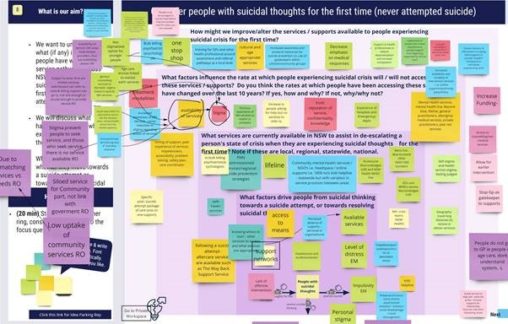
Over the past year, we’ve all adapted to remote meetings, remote learning, and even remote pilates. But when it comes to running remote collaborative health research workshops, things can get trickier. We talked to the Sax Institute’s Cindy Peng, Decision Analytics Manager, about her experiences moving dynamic modelling workshops online during the pandemic, and some of the lessons (and challenges) of virtual workshops.
Know what not to lose

Dynamic modelling has always been a hands-on process – involving a large group of researchers, patients, and policy makers gathering to map out their experiences of a particular health system. Cindy says this traditionally meant lots of butcher paper and sticky notes. “We would always lay out a lot of paper and notes so everyone could physically get involved in the workshop,” she explains. “This participatory process is a way of empowering and mobilising participants. And with pen and paper, we could encourage everyone to literally make their mark on the process.”
“COVID obviously changed that. So when we moved our workshops online, we looked at which key elements of a physical workshop we absolutely had to keep. For us, this meant prioritising building relationships (despite the tricky online format), as well as offering easy-to-use interactive technology so people don’t become disengaged, and ensuring everyone had a voice in workshops.”
Keep it a hands-on experience

When it comes to mapping a health system, Cindy says it’s not enough to stare at a screen. Attendees need to be able to take part in the mapping. “That’s why we use virtual whiteboards in all our workshops. It keeps it a hands-on experience, where attendees can add their thoughts to the communal discussion via virtual sticky notes.”
That said, the technology is sometimes challenging for those with little experience working with virtual whiteboards. Also, if there’s any kind of technology glitch, things fall apart quickly. Cindy’s recommendation is to keep the technology intuitive, so stakeholders don’t become withdrawn due to technical challenges. And “always have a workable backup plan in case the technology goes awry!” This includes virtual cues and Zoom chat for the facilitators to put in sticky notes for them.
Spend time listening and building relationships
One of the hazards of online workshops is the inability to have casual side conversations. “Which is challenging,” says Cindy, “because morning tea breaks are the perfect opportunity for frank conversations – where people often tell me their real concerns, rather than voicing them in front of the whole group.”
A simple pre-meet before online workshops is one solution she uses to maintain engagement and buy-in from attendees. “We ensure we meet everyone before workshops, which is time-consuming, but really valuable in the long-run because people can get their concerns out of the way, plus have a quick tutorial on the technology.”
Use the online format as an opportunity to help everyone talk
For some people, the thought of taking the online stage is inhibiting, but using multiple communication channels helps give everyone a voice.
In a recent suicide prevention workshop that included attendees with lived experience, Cindy says they had one person on private messages and calls, so attendees could let them know when the content was getting too difficult for them to participate. “In this way, we could be their voice,” explains Cindy.
“Attendees could message us, and this would be shared anonymously with the group. Or conversely, if they were finding it hard to get into the conversation, we could make space for them to take the floor. Having this messaging system really helped improve the power dynamic of virtual workshops.”
Small groups are good. And timing is everything
“Groups of 20 are hard online,” admits Cindy. “While we want to keep that really energetic group dynamic, we find we have to break up into two-to-four smaller groups to keep things workable.”
Breakout rooms are common in workshops, but Cindy runs them sequentially to make sure they can have ‘all hands on deck’ for each session. “We need at least four facilitators in each discussion, including one facilitating group discussion and maintaining overall flow, one managing private messages and calls, one simulation modeller, and one taking notes and on standby for technology or other assistance.”
One drawback of running smaller groups is that people can lose track of what they’re supposed to be doing without the usual physical cues. Clear instructions on small tasks helps. “And we use timers for everything,” adds Cindy. “Virtual sessions can be much more draining, so we include a visual timer for everyone to see.”
If you’d like to know more about the Sax Institute’s dynamic modelling work, please contact Cindy Peng at cindy.peng@saxinstitute.org.au
Find out more about the work of the Sax Institute’s Decision Analytics team here.





